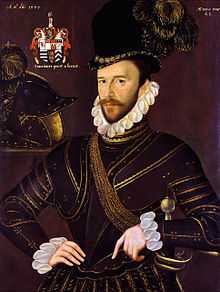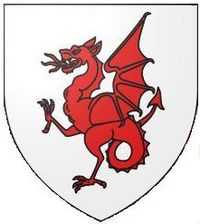Richard Drake
| Richard Drake | |
|---|---|
 | |
| Born | 1535 |
| Died | 11 July 1603 |
| Spouse(s) | Ursula Stafford |
| Children | Francis Drake |
| Parent(s) | John Drake, Amy Grenville |

Richard Drake of Esher (1535[1] – 11 July 1603), was Equerry of the Stable and Groom of the Privy Chamber to Queen Elizabeth I. He also held office as a Member of Parliament and Justice of the Peace.
Family
Drake was the third son of John Drake (d.1558), of Ash in the parish of Musbury, Devonshire, and Amy Grenville, daughter of Sir Roger Grenville of Stowe, Cornwall.[2] Drake had two older brothers, Sir Bernard Drake and Robert Drake.
Career
Drake was an equerry of the stable to Queen Elizabeth by 1577, and a Groom of the Privy Chamber in 1584. In 1589 he was appointed surveyor of game in Woking Park, and in 1590 steward (office) of the manor of Woking. As a courtier, Drake required a residence near London, and in 1583 he leased Esher Place from Charles, Lord Howard of Effingham.[2]
Drake combined service in the royal household with elected and appointed office. He was Member of Parliament for Morpeth in 1572, and for Castle Rising in 1584. He was a Justice of the Peace for Surrey from about 1591, and a commissioner for the subsidy in 1593.[2]
Drake is said to have been 'high in the Queen’s favour', and received valuable grants from her, including gold and silver from the Spanish Armada and a monopoly for manufacturing aqua vitae. In about 1602 the Queen granted him the residue of the moneys still owing to her from Sir Francis Drake’s voyage of 1585-6.[2]
Drake served as factor and prize agent to Sir Francis Drake (to whom he may have been distantly related), taking charge of the Spanish Armada prisoners taken off Plymouth in 1588, which included the Spanish vice-admiral, Don Pedro de Valdez,[3] whom he kept at his manor of Esher in Surrey,[4] pending arrangements for the ransom, a subject over which his heirs and those of Sir Francis quarrelled.[5]
Drake died 11 July 1603. In his will, made 31 May 1603 and proved 31 January 1604, he asked to be buried in Esher church, and appointed his only child, Francis Drake, as his executor. He left his widow, Ursula, his lease of the manor of Walton-on-Thames and the parsonage there, as well as a house in Fetter Lane, and his coach and horses. His other lands and goods, including the manor of Esher, were left to his son, Francis, who sold Esher after 1631. The ancient manor house had been a seat of Cardinal Wolsey, purchased from him by Henry VIII, temporarily returned to the see under Mary and eventually conveyed by Elizabeth to Charles, Lord Howard of Effingham, from whom Drake must have purchased it.[6]
Marriage and issue
Drake married Ursula Stafford, daughter of Sir William Stafford and Dorothy Stafford, by whom he had a son, Francis Drake (d.1634).[7]
Notes
- ↑ Gower's portrait, 1577, shows Drake aetatis suis 42.
- ↑ 2.0 2.1 2.2 2.3 Drake, Richard, History of Parliament Retrieved 18 March 2013.
- ↑ Calendar of State Papers, Domestic Series, Elizabeth 1581-1590, p. 542 Retrieved 18 March 2013.
- ↑ The transfer of the lease in perpetuity from the bishop of Winchester through the agency of Charles Lord Howard of Effingham, eventually passing to Richard Drake, is briefly detailed in 'Parishes: Esher', A History of the County of Surrey: Volume 3 (1911), pp. 447-451 accessed 5 July 2009.
- ↑ Harry Kelsey, Sir Francis Drake: The Queen's Pirate (Yale University Press) 1998:337.
- ↑ "Cardinal Wolsey at Esher," The Gentleman's Magazine 1879:363.
- ↑ Lipscomb 1847, pp. 153–4; Bridgeman 1883, pp. 18, 36; Ormerod 1819, p. 334; Richardson IV 2011, pp. 64–5.
References
- Adams, Simon (2006). "Stafford, Dorothy, Lady Stafford (1526–1604)". Oxford Dictionary of National Biography (online ed.). Oxford University Press. doi:10.1093/ref:odnb/69753. (Subscription or UK public library membership required.)
- Bridgeman, G.T.O. (1883). "Some Account of the Parish of Church Eaton in the County of Stafford". In Wrottesley, George. Collections for a History of Staffordshire. IV, Part II. London: Harrison and Sons. pp. 1–124. Retrieved 18 March 2013.
- Lipscomb, George (1847). The History and Antiquities of the County of Buckingham III. London: J. & W. Robins. pp. 153–4. Retrieved 18 March 2013.
- Ormerod, George (1819). The History of the County Palatine and City of Cheshire. London: Lackington, Hughes. p. 334. Retrieved 18 March 2013.
- Richardson, Douglas (2011). Everingham, Kimball G., ed. Magna Carta Ancestry: A Study in Colonial and Medieval Families IV (2nd ed.). Salt Lake City. pp. 64–5. ISBN 1460992709.
External links
- Will of Richard Drake of Esher, Surrey, National Archives
- Drake, Daphne, Drake of Ash or Ashe Retrieved 18 March 2013
|